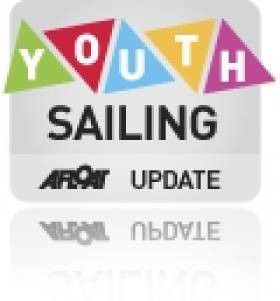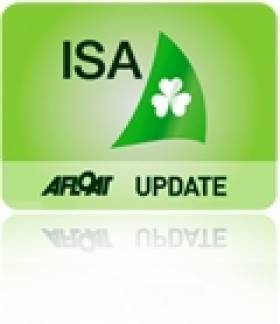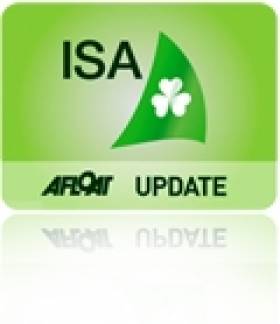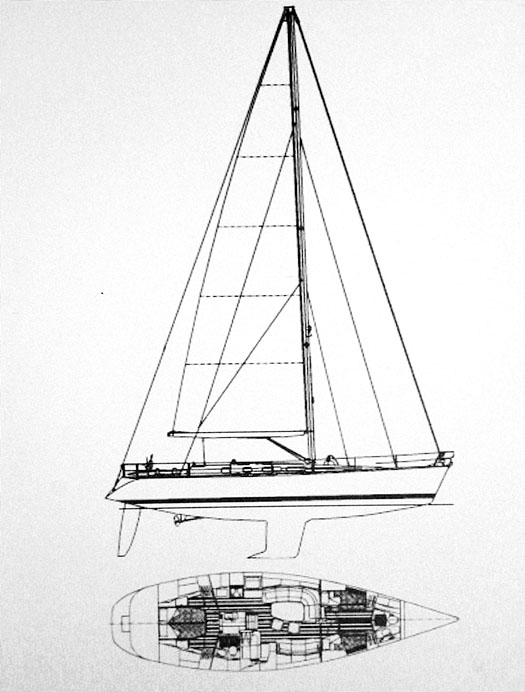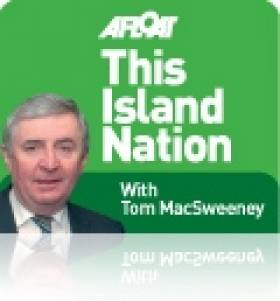Displaying items by tag: sailing
Voices Across The Pond Call For Sailing Growth
#Sailing - Scuttlebutt Sailing News has highlighted some North American voices adding to the chorus that calls for a renewed emphasis on dinghy sailing and encouraging a broader base of participation in the sport.
Former ISAF president Paul Henderson shared his thoughts on the elements that grew the sport of sailing over the past four decades, and what he believes is holding sailing back today.
Aside from the expense of new boats and the emphasis on single-handers and college sailing that prioritises the most elite athletes, the Canadian sailing hand also believes yacht clubs in North America "have forgotten what they are about... [thinking that] regattas should be a profit centre, rather than the hosting the sailors cheaply as the raison d’etre of a yacht club."
Meanwhile, US Sailing president Tom Hubbell has added his own suggestions for introducing young newcomers to the sport through the one-design classes - via mentoring, networking socially and, very importantly, limiting failure so that young sailors will be encouraged to return again and again for more.
Their comments come after former ISA president Roger Bannon's candid assessment of the state of sailing in Ireland today.
According to Bannon, the "importance of supporting elite and Olympic sailing" must become "a subsidiary focus to the main objective of getting people sailing competently and safely in whatever boat they wish".
American Sailing's Great Survivor
#offshoresailing – There were four of them, back in 1968 in New York. There was Dick Nye (1903-1988). Briefly a theatrical hopeful, he'd got no further than spear carrier in an opera. But Broadway's loss was Wall Street's gain – the ebullient Nye had a stellar career in the wheelings and dealings of mergers and acquisitions and takeover battles, and this funded a love of offshore racing which he hadn't discovered until he was 44 .
Also present was his son Richard B Nye, business colleague and longtime shipmate in a hugely successful shared offshore racing career on both sides of the Atlantic, and across it. "Richard was the detail guy. Richard could remember every tack and sail combination on every race they had ever sailed. I only exaggerate a little. Between the two of them, they got maximum performance out of boat and crew."
The speaker is Sheila McCurdy, Commodore of the Cruising Club of America 2011-2012. She knew the Nyes well and sailed with them too, as she is the daughter of the third man present, yacht designer Jim McCurdy (1922-1994). Having served his time with the great Philip Rhodes, rising to head the Rhodes office's sailboat division, he had now set up his own partnership with his former boss's son Body Rhodes, and a new 48ft offshore racer for Dick and Richard Nye was one of McCurdy & Rhodes' first commissions.
McCurdy worked harmoniously with the Nyes. In 1955 in the Rhodes office, he had overseen the creation of their previous boat, the 54ft yawl Carina II, which had won both the 1955 and the 1957 Fastnets overall, and her class in the Bermuda Race too, plus a couple of Transatlantics. Carina II had been and still was a great boat, but the CCA rule had moved on. Being a beamy centreboard yawl had been a rating disadvantage under the RORC Rule, which made Carina II's Fastnet double all the more remarkable. But by 1968 it no longer conferred any advantage under the American rule either, something which was expected to be emphasised with the new International Offshore Rule.
It was hoped this ground-breaking global measurement rule would be unveiled by 1970. However, the Nyes - once they'd decided to move - were men in a hurry, and in August 1968 with Jim McCurdy they finalized a design which they reckoned would be a useful template for those framing the IOR. It was that and more.
The boat which emerged from their deliberations became the fourth member of the quartet, a personality in her own right. And with the death of Richard B Nye on March 14th at the age of 81, only Carina is left - American sailing's great survivor. She is still winning major offshore races in her fifth decade, still giving enormous pleasure to all who sail on her, and comfortably belying her age of 44 with timeless good looks.
She was built in aluminium, and kept as simple as possible. How about teak laid decks, even with their inevitable weight? As they say on Wall Street – fuggedaboudit. It wasn't that the Nyes were tight with the money, though they did shop around for value – their previous Carina had been built in Germany in a yard near Hamburg, as that offered the best deal at the time. But they readily spent money on the boat, particularly on the sails and rig, when genuine benefit would result.
And Jim McCurdy had an interesting approach to expenditure in building one-off yachts. Despite being of Ulster-Scots descent – you'll find McCurdys on Rathlin Island, and they're big around Ballymena and in The Glens – Jim McCurdy had a refreshingly open attitude to budgets, at variance with the popular perception of the Ulster-Scots' reputation for parsimony. In response to questions from Arthur Beiser for the latter's authorative book The Proper Yacht (Second Edition 1978), McCurdy suggested that anyone thinking of building the dreamship should consider "throwing financial responsibility to the winds and grabbing your dream as it slips away into an even more unfriendly future. There are those who have acted in this fashion and their irresponsibility turned, in fact, into wisdom that produced a great reward in enjoyment of sailing".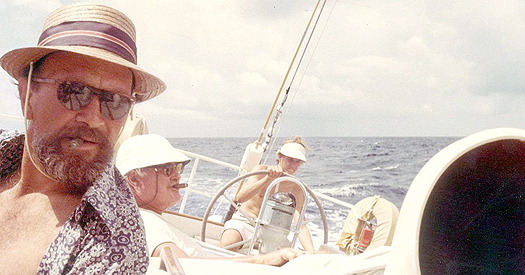
Jim McCurdy and Dick Nye aboard Carina in the 1972 Transatlantic Race to Spain, which they won by a huge margin. They were both great men for their cigars, earned here after a tactical gamble had paid off in spades.
Another time, he commented that those who concentrated on saving the pennies at every stage ended up spending more and achieving less than those who took the broader more generous view. Certainly with the previous Carina, when the Nyes' Wall Street speciality financial services firm was a much more modest operation than had become by 1968, the yacht style finish was to the highest standard, with all the trimmings. But with the sparse new boat, all was in line with the purpose of providing performance with just the basics of comfort needed by dedicated amateur crews for long races, and this remarkably handsome yet decidedly non-yachty sloop made her international debut at Cork in July 1969.
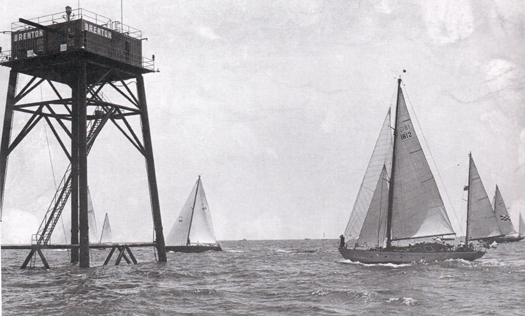
Shortly after the start of the 1969 Transatlantic Race to Cork, with Huey Long's maxi Ondine and the new Carina leading the only Irish entry, Perry Greer's Helen of Howth, past the Brenton Reef Light Tower. Photo: Tom Matthews
She'd raced Transatlantic, against a fleet which included one Irish entry, Perry Greer's John B Kearney-designed 54ft centreboard yawl Helen of Howth, which ironically had in some ways been inspired by the previous Carina. But Helen's owner was an inveterate gadgeteer and liked his cruising comforts. Even in racing trim, the Irish boat was no more than a fast cruiser, floating well below her designed waterline. The new austere Carina by contrast was very much a contender. So although in a big boat race to Cork the winner was the souped-up 12 Metre American Eagle from the 66ft S&S yawl Kialoa – Ted Turner from Jim Kilroy: there were giants in ocean racing in those days – Carina won her class in style, and her crew were enthused about her easy speed and good handling characteristics. Even today, after hundreds of thousands of miles, it's said she has never broached.
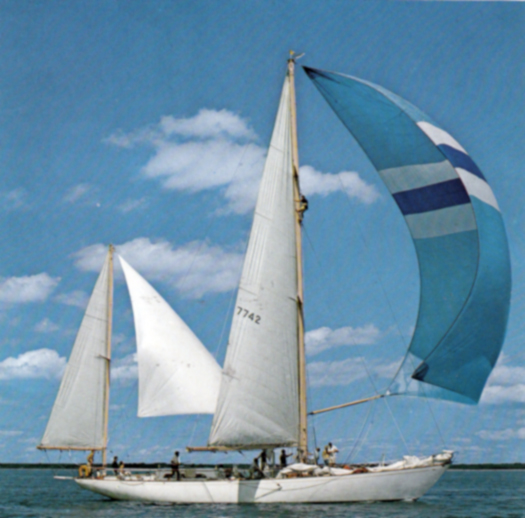
Jim Kilroy's 66ft yawl Kialoa II placed second in the 1969 Transatlantic Race to Cork.
That Cork visit resulted in Transatlantic links to the Nyes which two years later in 1971 had the 22-year-old Ron Cudmore sail as crew on Carina in a fast delivery passage across the Atlantic. Dick Nye wanted to get to the 1971 Admirals Cup, Ron wanted to get home from the US, and as no Transatlantic Race was scheduled, they could sail the northern Great Circle route with no mandatory waypoint to keep them clear of ice. Carina zapped across in just over a fortnight on the open ocean - "Fast and very cold," as Ron recalls. "great boat, awesome skipper".
Another Irish sailor who particularly remembers her arriving in Crosshaven back in 1969 is Neil Kenefick. Aged 11 at the time, he and his father were invited to sail on Carina from Cork to Kinsale as the Nyes fitted in a tiny bit of cruising before heading off for Dick Nye's favourite regatta, Cowes Week, which included the Admirals Cup in which Carina was a member of the winning American Team.
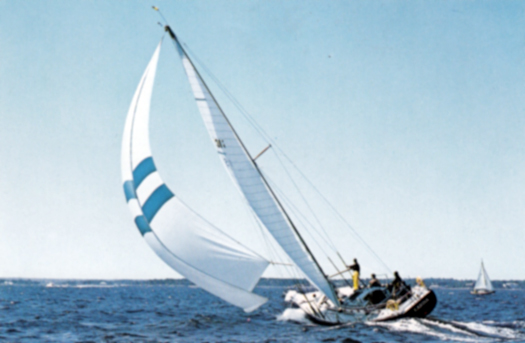
Carina on the Solent in 1969, when she was a member of the winning American Admiral's Cup team. It's said that she has never broached, and here – tight spinnaker reaching under her original configuration of smaller rudder with trim tab on keel – she is giving the helmsman no problems.
Neil met up with them again in Cowes ten years later, when he himself was on the then-leading Irish Admirals Cup team aboard Golden Apple, and the Nyes were properly impressed. But Golden Apple was a 1979 Fastnet casualty, along with Ireland's Admirals Cup hopes, whereas Carina went round in style with three generations of Nyes aboard – Richard B's son Jonathan was in the crew. At the height of the gale Dick Nye, aged 76, roped himself into the cockpit the better to savour this storm of storms: "This is GREAT" he bellowed, "truly utterly GREAT!"
The boat had already won a Bermuda Race overall, and in 1982 with the old man finally feeling his years and retired from offshore racing, Richard Nye sailed as skipper on his own and Carina won the Bermuda Race overall again. The successes continued, but by the mid '90s the junior Nye was looking back on fifty years of active offshore racing. So Carina found an excellent new home with Rives Potts, whose CV included crewing for Dennis Conner in 12 Metres, and very varied boatyard work – it was he who had done most of the work in the angle-grinder event in Bob Derecktor's famous yard when Carina was given an up-dated keel and rudder profile to Scott Kauffmann designs in 1978.
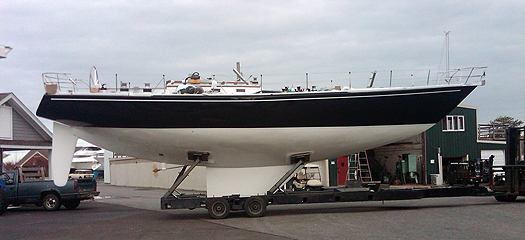
Carina's hull profile as it is today, with the new keel-rudder configuration to Scott Kauffmann designs fitted in 1978. Originally she's had a skeg-hung rudder with a trim tab on the keel. Photo: Rives Potts
Since then in Potts ownership, the only significant change has been a new mast in carbon. It has been noted that it lessens pitching. But other than that, this is still the same Carina, immaculately and lovingly maintained. In 2010 she won the Bermuda Race overall, then in 2011 she came cross the Atlantic and won Class 5 and placed fifth overall in the record fleet in the Rolex Fastnet Race. Then she simply sailed straight off to Sydney under the command of the next generation, and got sixth in class in the Hobart Race and won the informal "father-son" division, and then sailed on round the world with a particularly impressive east-west crossing of the Indian Ocean from Perth to Cape Town to get back to the US just in time for the Bermuda Race 2012, and she won overall in that yet again.
She won't be in the Fastnet this year, but it's likely she'll be back in 2015. Rives Potts is a flag officer of the New York YC, which will sending a fleet across for the Bicentennial of the Royal Yacht Squadron. And in that fleet, the boat for true sailors will be this modest 46-year-old black sloop, American sailing's great survivor, a global superstar.
THE HIPPY HAPPY MIRROR DINGHY
Did you know there used to be Mirror dinghies for hippies, driven by flower power? Believe me, there were – we bought one for family use back in 1977 from a former suburban hippy round Dun Laoghaire way. Instead of a simple paint job for the hull, she was decorated in flowers from end to end.
The guy we bought her from was Norman Long. These day, he is of course F. Norman Long, senior sailor emeritus, pillar of the yachting establishment, and basking in the deserved glow of having played a key role – along with Theo and Avril Harris - of getting the annual frostbite series inaugurated under the auspices of the Dun Laoghaire Motor Yacht Club, way back in 1974 or even earlier.
But in his more relaxed moments yonks ago, Norman would have dreamt of making the scene in San Francisco. I don't think he got there, yet he grew his hair long, and he painted his boat with psychedelic flowers on a pink background. But regrettably, it wasn't that which drew us to the boat. We simply wanted a Mirror dinghy because it offered so much for an impecunious family with two small children and another on the way, and Norman's was for sale as he was getting involved with offshore racing.
The Mirror was the right choice for us. They're great little big-hearted boats, one of the cleverest dinghy design concepts of all time. She gave us two happy summers and was everything we needed for local mini-cruises – some boats twice the size couldn't carry as many people - and the very occasional race. But it wasn't until the flowers had gone that we made our debut with our new pride-and-joy. We smuggled her back home on the roof of our battered little car, and hid her in the garage - it hadn't become an office in those days. When she reappeared, immaculate yacht white with a neat dark green boot-top – a proper boot-top, not silly stripes – the neighbours thought it was a different boat entirely.

Mirror action at Rosses Point in Sligo. This year the class is celebrating its Golden Jubilee, and the Worlds are at Lough Derg in August.
Photo: Bryan Armstrong
These fond memories are evoked by the fact that this month marks the Golden Jubilee of the Mirror Class Assocation. It was actually 1962 when DIY guru Barry Bucknell and ace dinghy designer Jack Holt pooled their considerable talents to produce the smallest possible boat which could do just about everything, and they succeeded brilliantly. Of course they're now mainly known for their racing, but for simply sailing they're great too, and seaworthy with it – one intrepid Mirror sailor managed to get all the way from Shropshire in England across Europe to the Black Sea.
The essence of the design is that it was dictated by what could be done with marine ply by amateur builders. The stitch-and-glue technique conferred strength and shape, while the need for economy and internal space dictated the pram bow.
Inevitably over the years, racing demands have meant that people have lost sight of the original very basic concept. For instance, they now have bermudan rig, where originally they'd a sensible sliding gunter set-up with all the spars stowable within the hull when un-rigged, which was very user friendly.
Less user-friendly was the need to keep weight and price down, thus they were built with ultra-light inexpensive plywood, of marine standard but pushing it a bit. It couldn't be neglected at all. So in time there were attempts to build competitive boats in lower maintenance glassfibre, and when the Worlds were held in Ireland in 2001, the Australians turned up with plastic boats which did the business.
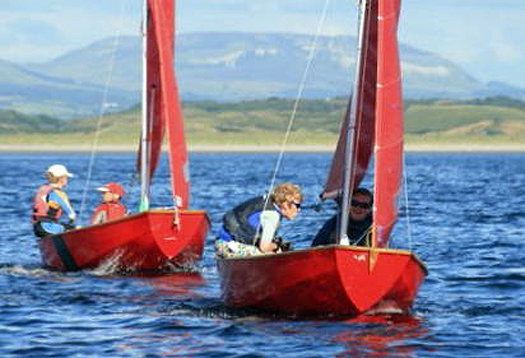
The shape of the Mirror dinghy is dictated by the demands of plywood construction, and the need for economy and light weight.
Photo: Bryan Armstrong
But in the long run, it's absurd to use fibreglass to build boats whose shape was created in the first place by the unique demands of plywood construction, utilising a totally hard chine shape. We mentioned that here some weeks ago in considering the 30ft van de Stadt-designed Royal Cape ODs. Those slippy little plywood sea sleds had given so much sport that somebody though it would be a great idea to build them in more durable glassfibre. But only four were built in plastic as the absurdity of sticking to the confines of a totally plywood design concept became obvious.
It should be possible to create a design which has the Mirror's excellent roominess, attractive sailing ability and compact size, while taking much greater advantage of the shape options which plastic construction offers. But of course, such a boat would need all the hassle of creating a new class, with its essential dedicated adherents. The Mirror dinghy comes with its own extraordinary ready-made hinterland of wonderful memories and great sport.
So we wish them a very happy 50th Birthday. And where does an impecunious sailing family go after two great years with a Mirror? Into a Squib of course – where else?
#dinghy – A packed National Yacht Club (NYC) in Dun Laoghaire heard important contributions from clubs and classes right around the country this morning at a forum to revitalise small boat sailing and youth training. It is the first step on a new blueprint to stem falling numbers in Irish sailing.
Although the contributions varied from the reintroduction of junior log books to coaching support for senior dinghy classes, delegates were united in the view that the Irish Sailing Association (ISA) has to change tack if it wants to properly support the clubs and classes it aims to represent.
The meeting opened with a welcome from association president Niamh McCutheon who urged everyone to work together for the sport. It was followed by an overview of the problems in small boat sailing and how youth training can be made more relevant to clubs and classes by Roger Bannon, a former president of the association. Bannon has been openly critical of the association's performance in recent weeks. He told the meeting there are serious problems with Irish small boat sailing and that important changes are needed, some of them quite fundamental, to ensure the future vibrancy of our sport.
In many ways the packed club house was testament to his concerns that Irish small boat sailing is in trouble. The full extent of the problem was starkly put into focus with the publication earlier this week of information which showed an alarming decline in attendance figures at dinghy championships and falling participation in junior training schemes.
Former president Paddy Maguire, who chaired the meeting, asked attendees to make four minute contributions and they did not need much encouragement with passionate contributions from champions, instructors, youth sailors, University team racers, senior dinghy sailors, sailmakers, sailing school owners, club commodores and junior organisers.
Norman Lee, the GP14 sailor who originally proposed the motion for change at the ISA agm a month ago said that the ISA had started its life as the Irish Dinghy Racing Association (IDRA) in 1947 but it was now so far off course it more resembled the Concordia, a reference to the ill–fated cruise liner that ended up on the rocks last year.
There were plenty of good quality suggestions for the combining of open events and even the restaging of dinghy week to reinvigorate the small boat scene.
As has been documented on Afloat.ie over the past few weeks the meeting heard a range of contributions from up to a dozen or more delegates with applause after each contribution and included observations such as:
• Numbers participating in dinghy and small one design boats are steadily declining in both youth and adult classes. There are some exceptions, mainly in older traditional classes but unfortunately, this decline represents a fundamental underlying overall trend.
• The retention rate of junior sailors in the sport, after emerging from our training schemes, is alarmingly low, at less than 10%.
• The standard of sailing and racing skills amongst juniors is in general, unacceptably inadequate and they lack even the basic skills to participate in crewed boats with multiple sails.
• The expected natural progression of youth sailors into adult classes as they mature is virtually non-existent.
• The general standard of racing and boat handling skills in most adult classes is also considerably below acceptable levels and certainly much lower than in prior decades.
• The justified emphasis placed on elite sailing has been implemented at the expense of improving standards generally and supporting international participation in non-pathway approved classes to improve skill levels.
• The quality of our training instructors is very mixed and many of them do not have the basic sailing and racing skills to train junior sailors to even a modest level of acceptable competence. It is also incredibly expensive to obtain qualifications to become an Instructor and this dis-incentivises many who might be excellent candidates.
• The ISA is not properly engaged with its members and is devoting a disproportionate share of its resources to service interests and activities which are not relevant to the vast majority of its 20,000 members. This state of affairs has emerged despite quadrupling the staff compliment compared to the late 90's and generating in excess of €2m in annual revenue. Of course it has to be acknowledged that over 50% of this is ring fenced Government funding for our excellent elite and Olympic support programs and for financial support towards the hosting of specific major international events.
• There is a universal concern that the ISA is not providing leadership on important issues which are of the most relevance to its members including its affiliated clubs, many of which are experiencing serious challenges.
For the final item attendees were asked to submit suggestions on paper in bullet point form as to how these issues can be addressed in the short and long term. It is understood over 300 suggestions were received.
The meeting ended at 1.50pm with a commitment from the ISA to distribute minutes to all attendees and to publish its report and action plan.
Sailing Colleges Converge on Kerry Waters
#teamracing – The chances in Ireland of snowfall on St Patrick's Day are statistically better than the chances of the white stuff coming down on Christmas Day. The reason we haven't really got our heads round this notion is that in mid-March, it just disappears like....well, like snow off a ditch.
But spare a thought for the suffering citizens of southeast England. They effectively enjoy a Continental climate, which means their average chances of snowfall at Easter are higher than at Christmas, even allowing for Easters in late April.
Not so in Ireland. But nevertheless if you want to get the best of what's available in sailing over the Patrick's Day holiday, and reckon that the sea at its coldest is quite enough to be going along without rain falling as snow showers too, then head southwest pronto.
Twenty-eight university sailing teams have done that very thing, heading for Kerry and converging on Fenit in Tralee Bay where University of Limerick are the organisers of the annual Irish Intervarsities, team racing in Fireflies, with Tralee Sailing Club providing the facilities for the opening event of what promises to be a very busy season, as they have both the WIORA and ICRA championships down there in June.
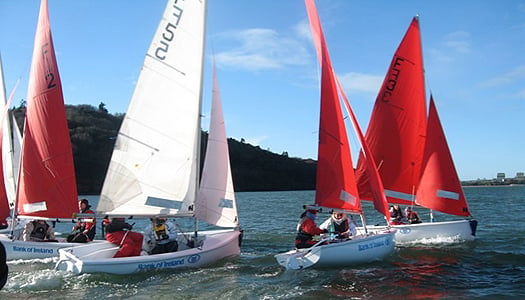
It may be 68 years since Uffa Fox designed the Firefly 12ft dinghy for mass production in hot-moulded multi-skin timber - "cooked life a waffle" - but it is still a favourite for the special demands of team racing, and more durable these days with GRP construction
The TSC season explodes into life this weekend, as the three-day Intervarsities zapped into action promptly at 1000hrs yesterday, with 72 races scheduled each day. Then today both the Tralee Marathon and Half Marathon come trotting through Fenit. And tonight, the club throws its traditional Launch Party, one of the more boisterous events of the year. As Commodore Pat Daly commented earlier this week, after a winter of slumber the members don't know what's going to hit them, but they'll enjoy it anyway.
For sure, they have the place to do it. The rest of Ireland tends to think of northwest Kerry as a wild and woolly place. But in fact Fenit is a snug little spot, with a sheltered south-facing coastline between it and Spa in towards Tralee town, while sailing in the impossibly beautiful bay has been transformed by the top class marina out at the harbour on Great Samphire Island. Yet it's less than an hour's sail across the bay to the Maharees, which is pure Atlantic Ireland, a place apart where they create the finest racing naomhogs on the west coast.
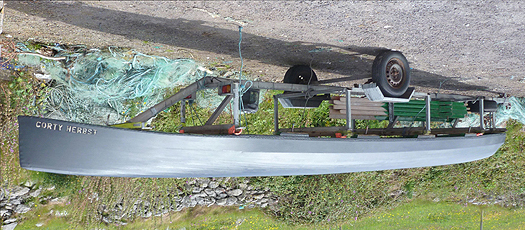
Do not adjust your set....we have inverted this photo, taken July 2012, in order to better show the highly-refined racing naomhog Corty Herbst at the Maharees in Kerry. Corty Herbst (1924-2000) was an American who settled in the Maharees with his wife Joan in 1969, and became much involved with the local racing currachs, playing a key role for many years in organising the Maharees Regatta. Photo: W M Nixon
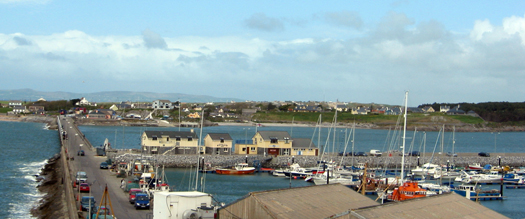
Fenit's 130-berth marina is a friendly place, and the harbour is a fine example of practical co-existence between fishing boats, recreational sailors, and commercial shipping. Photo: W M Nixon
The harbour on Samphire Island is reached along a 0.75 km causeway and bridge which is always well lined with sea anglers, who live in a world of their own. If you arrive in aboard a cruising boat, you'll find it takes exactly seven minutes to walk that bridgeway to the nearest pub, and another couple of minutes to get up to the club. But as the Intervarsities are dinghy focused, everything will rotate around the fine clubhouse in its prominent position above its own launching slip and an excellent sailing area which is ideal for an intense event like this, as it offers several options to cope with changing wind directions.
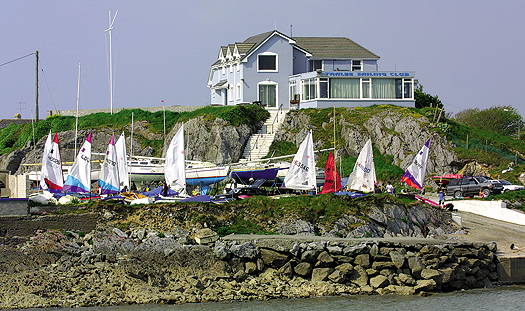
Tralee SC is at the heart of a boat-orientated complex which includes a busy sailing school
Having a major event so early in the season is always a bit of a gamble, but the pattern of the university year dictates the timing. This weekend's series is emphatically the Team Racing championship, which automatically secures the winners a place in the massive British University Team Opens at the end of April. But during April, the Irish colleges will also be in pursuit of a place in the Student Yachting Worlds in France at the end of October, very high on the agenda as UCD won it in 2012, so they already have a place as of right.
Thus there'll be an extra place up for grabs by whoever can top the Irish Worlds trials in April, which will be raced in the SailFleet J/80s. They're based in Howth this year, and the college trials will have racing on April 6th, 13th and 20th. It's all of more than academic interest, as the Student Yachting Worlds will also be raced in J/80s, which provides the prospect of the good old one two for Irish university teams at world level. Dream on.....
As for this weekend, it's the gallant Fireflies which are the workhorses for the three-boat teams. The logistics are mind-boggling, and UL's Robert O'Leary – best known in recent seasons as the helm out of Crosshaven on the family's cruiserfied 1720 Antix Beg – has stood back from being on the team in order to concentrate on the Sisyphean task of keeping things on schedule, or maybe even a bit ahead of the sched, as the winds might be pushing towards gale force northerlies later tomorrow afternoon.
With Irish women being way ahead of their male counterparts these days in success in international sports such as rugby, boxing and sailing, it's no surprise to find several of the leading teams in the Intervarsities on Tralee Bay have women captains, with University of Limerick – very much the pace-setters in college team racing build-ups earlier this year – headed by Lauren Joslin, while the international stars of UCD are captained by Zoe Flood.
Yesterday saw the first day of racing blessed with much better weather than was being been anticipated at mid-week, with Tralee Bay enjoying its own favourable micro-climate while massive clouds passed to north and south in a 12 to 16 knot westerly which was enlivened by only a couple of rainsqualls on the bay. That said, a "small hailstorm" was a reminder that winter has barely released its grip, but there was plenty of sunshine and spring was in the air.
University of Limerick lived up to the promise of earlier events this year with wins in all their races, while UCD were next with five wins out of six, followed by TCD. Today should see the programme moving along with northerlies and clearing skies, and there's an improving chance that the northerly gales being mentioned for tomorrow will be far enough west to allow the programme's smooth conclusion.
GATHERING THE GAFFERS
Trying to assemble a fleet of boats and then get them moving in any sort of co-ordinated way is about as easy as herding cats at a crossroads. It's a good explanation for the appeal of racing – put up a prize and start firing the guns in the starting sequence, and there's just a chance some sort of order might prevail.
Another technique is finding some anniversary of recognisable significance, and building an event around it. The word is that the Irish Cruising Club are going to have a Octogintaquinquessimal Cruise-in-Company in southwest Ireland next year to celebrate the 85th Anniversary of the founding of the club in Glengarriff on July 14th 1929. Anyone suggesting that if they could just hang on for another fifteen years, then they could have a real mega-celebration for the Centenary, is sharply reminded that the club has a very significant membership cohort of extremely senior seniors in a hurry, and they want to Do It Now.
Meanwhile, it seems the notion of a Golden Jubilee cruise this summer for the Old Gaffers Association in the form of a rolling circuit of Britain with two stopovers in Ireland, and boats joining and leaving as they please, is proving popular. Sign-ups for the Dublin visit from May 31st to June 4th have already gone through the fifty mark, with the style being set by some fine big cutters such as Brandaen from the Netherlands, Annabel J from the Solent, and Adrian 'Stu' Spence's 1875-vintage Pilot Cutter Madcap from Strangford Lough.

The impressive Dutch cutter Brandaen has signed up for the Old Gaffers Golden Jubilee Cruise-in-Company, which comes to Dublin Bay from 31st May to 4th June.
It's all a long way from the first assembly in Ireland of boats intent on celebrating the special joys of gaff rig, which attracted precisely three craft to Dunmore East in 1955. For a long time there'd been amiable arguments as to which was the faster boat between the Cork Harbour One Design of 1895, and the similarly-sized Dublin Bay 21 of 1902. With Dinghy Week 1955 being staged in hospitable Dunmore East, a midway port of sorts, two Dublin Bay 21s and two Cork Harbour ODs set out from their respective harbours to meet for the first time ever in Dunmore for a deciding contest which would have the benefit of being witnessed by racing experts.
The weather decided otherwise. Not through gales, but because of an enormous flat calm. In Cork, the two CHODs were towed out of the mirror-like harbour mouth, but the tide brought them back in again, so one of them – Cygnet - moored to a navigation buoy. When the tide turned again to offer the chance of a second attempt at departure, in the hassle of releasing themselves a crewman was left behind on the buoy (I'm not making this up), and the sluicing ebb meant they couldn't return to collect him.
Fortunately George Radley's Querida was further back, and she was able to collect the stranded crewman in passing, so to speak. They made it to Ballycotton that night, and then to Dunmore East the following day. But only one of the Dublin Bay 21s made it over the longer distance from Dublin Bay. This was Naneen owned by Michael 'Styx' O'Herlihy, who the following year sailed to America on the Kearney 6-ton yawl Evora, and made his fortune in the US as producer of the successful TV series Hawaii Five-O. His crew was the youthful Cass Smullen, and it took the pair of them fifty hours to get to Dunmore East, which made Dyko Morris, who retired from the voyage at an early stage with his DB21 Geraldine, even more convinced he'd done the right thing.
With an element of exhaustion and over-exuberant celebration at getting to Dunmore East at all, the actual races don't seem to have been totally conclusive, in fact there were only a couple of contests with one day lost through gales. Honours were fairly even – the Dublin Bay 21 had the edge in lighter breezes when her topsail could be set, but when it piped up the Cork Harbour OD, with her high-peaked gaff main and never carrying a topsail, seemed to have the best of it.
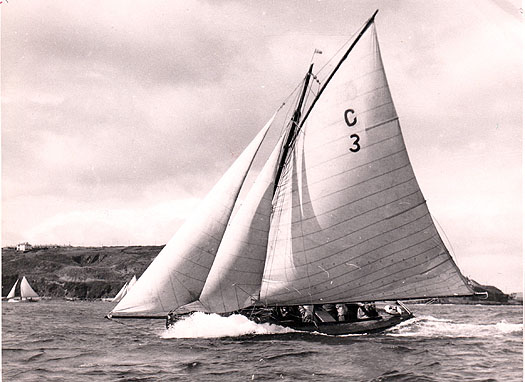
Cork Harbour OD in classic style, with high-peaked gaff mainsail, but no tops'l, romping seaward from Cork Harbour. The restored boats will be having special races at Cobh Traditional Sail Regatta from June 28th to 30th. Photo: Tom Barker
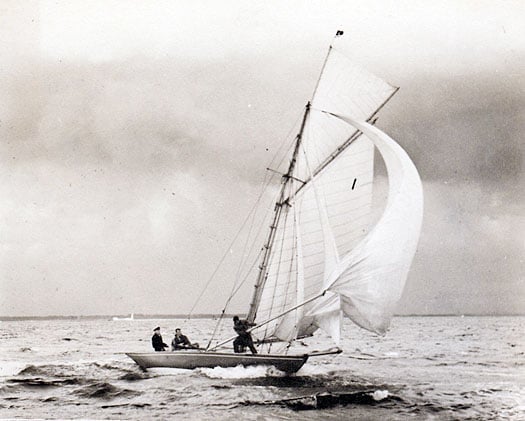
When the Dublin Bay 21 could carry her topsail, she seemed to have the edge on the Cork Harbour OD, but the Cork boat seemed faster in strong winds.
Years later, Styx O'Herlihy and George The Rad used to wax nostalgic about this unique event, for in hindsight it was a sort of last hurrah. In 1963 the Dublin Bay 21s decided to change to Bermudan rig, and at much the same time the Cork Harbour One Designs were being turned into Bermuda rigged cruisers, for which they did very well. They'd heftier hulls than the Dublin Bay 21s, and thus could provide more accommodation, and at a time before bare hulls in fibreglass for home completion as cruisers had become available, it was a useful option for an economy cruiser.
The story takes an odd turn, for although the Dublin Bay 21s stayed together as a racing class, they ceased to function after the damage in Dun Laoghaire harbour by the remnants of Hurricane Charlie in 1986. But the Cork Harbour One Designs found new life as Bermuda-rigged cruisers, and thus survived in order for several of them to be converted back to their original gaff rigged racing setup as the interest in classic yachts grew. Particularly notable was Jap, which was found in a hidden creek of Falmouth Harbour and brought magnificently back to life for Clayton Love Jnr by Fairlie Classics. He notched many classic regatta successes with her before selling her on to David Sheriff, who last year skippered Jap to top boat overall in the Classics Regatta at Cowes in July.

With their conversion to Bermuda-rigged cruisers as seen here in 1981, the Cork Harbour One Designs survived to avail of the classics revival, which has seen several of them restored to original form. Photo: W M Nixon
This year there'll be a chance to see the restored local fleet of Cork Harbour One Designs in action at the Cobh Traditional Sail Regatta from June 28th to 30th. Whether or not we'll see any of them making the scene for the first time ever in Dublin Bay with the Old Gaffer events four weeks earlier is probably mostly a matter of logistics. But if they're heading for the east coast, they can rest assured there's no requirement to leave a crewman behind on a navigational buoy on the way.
Comment on this story?
We'd like to hear from you on any aspect of this blog! Leave a message in the box below or email William Nixon on [email protected]
Former ISA President Calls for Change in Irish Sailing Debate
#isa – Roger Bannon has a lot to say about the state of Irish sailing. The former president of the Irish Sailing Association (ISA) - and a dinghy and sportsboat champion in his own right - used his term in office two decades ago to secure the position and financial viability of the association as a national sporting authority by making every member of a sailing club in Ireland also a member of the ISA.
It was a bravo move that unified Ireland's sailing clubs into a stronger whole fit to nurture the talent necessary to challenge the world at the top levels of sailing. But in more recent times that fitness has been called into question, and Bannon is among those hitting out at an authority that has arguably lost its relevance to all bar those at the most elite levels in the sport.
"The ISA has lost its way over the last few years," he says, giving his view of a bureaucracy "detached from the reality of what is going on in the front line".
Resulting from the reforms he spearheaded in the early 1990s, the ISA became "a creature of the clubs", but he believes that the clubs have now "lost control as the professional team in the ISA grew and began to exercise increasing influence on key decisions".
Things came to a head before the recent ISA AGM, where a motion was tabled to 'shake up' ISA policy to stem the decline of dinghy sailing in Ireland. Bannon is among many in the sport - regatta organisers, commodores, champions and racers alike - who credit the decline of dinghies and one-design sailing with the national body's disproportionate emphasis on the Olympic classes. But they're not the only ones in the crosshairs.
"The clubs have also a lot to answer for in this respect," he says. "They were all mesmerised by the easy money of the Celtic Tiger era and lost sight of the value-for-money issues as well as the primary responsibility to look after their members' sailing interests."
Bannon posits the "major disruption" cause by the hosting of "too many 'status' events", and what he sees as the unjustifiably high costs of access to club facilities, as significant factors in the decline of classes such as the SB20 in Dun Laoghaire alone.
And there is "another elephant in the room", he says, referring to the financial struggles among even the biggest of Ireland's sailing clubs, many of which have been cutting fees - some even doing away with them altogether - in an attempt to attract new, younger members.
"Most clubs have worryingly ageing membership profiles which leads to less sailing activity, particularly racing," says Bannon. "This is a disturbing spiral accentuated by the fact that we are also losing nearly all the juniors who we train at great expense because our sailing curriculum is not focussed on generating a lifetime love for or a competence in the sport."
He puts this outcome squarely at the door of the ISA and its policies "both in terms of training emphasis and boat selection. This has huge structural consequences for the future viability of clubs and for the sport in Ireland."
Sailing in crisis
Bannon doesn't mince his words when he says "Irish sailing is truly in crisis". And his reasons for feeling that way are manifold.
The former ISA president references "needless bureaucracy and expense of qualifying" as an instructor with no thorough assessment of sailing or racing capability.
He even explains the decline in the progression of juniors into senior sailing as a result of "undue anxieties about the political correctness of young people spending extended leisure time with adults .... We also largely train our kids in single-handers and they have no idea of how to sail team boats or double handed dinghies."
Such issues are of course not unique to Ireland, but Bannon says the "macro policies emanating from the ISA have certainly not helped. The clubs do not realise a revolution is under way and most are burying their heads in a nostalgia for what they believe has worked perfectly for the last 30 years."
It's reasons like this that prompted the aforementioned motion to save dinghy sailing, but one factor of a growing resentment among those who want to see Irish sailing adapt with the times - as opposed to the ISA which, Bannon says, sees "nothing wrong with the status quo" of the current top-down strategy.
"After all, despite reducing capitation revenue from the clubs, Government funding is freely available for sailing after the Olympics, the hosting of many major prestigious events and the activism of some in the ISAF."
He also criticises the "detachment" he perceives among the ISA's executives, noting that in advance of the upcoming meeting on the dinghy sailing motion on 23 March, all classes in Ireland received a letter "looking for information about attendance figures at national championships over the last five years. Surely it would be expected this kind of important data would be readily to hand in the ISA? It certainly used to be in years gone by."
Bannon says that when "this unhappiness was articulated at the recent ISA AGM, the ISA's initial reaction was to kick it down the road for a year" but that position quickly changed "when they realised the depth of feeling ... about the urgency with which this all needed to be addressed".
The message, he says, was clear: the ISA needs to refocus its priorities. And it starts with the meeting on 23 March at the National Yacht Club, at which Bannon will represent the DBSC Mermaid, and which "must be effective in changing things and redirecting our national governing sports authority to do what we require.
"After all, it is our organisation, of which we are all individual members, and to which we contribute significant financial resources personally through our clubs."
Meanwhile, there is the problem of encouraging casual sailors perhaps alienated by the ISA's professional focus to get back on the water. Bannon cities "conservative" estimates that there are "over 500 Mirror dinghies stored in garages and gardens around the country ... Will somebody explain to me why not even 20 per cent of them are being used? Talk about a lost opportunity for low-cost youth sailing."
Ultimately, he says, "we have collectively lost our way and need to seriously reassess. Too much of our effort is directed at producing international sailors while 99.9 per cent of sailors never aspire to these dizzy heights. Does this not smack of misdirected emphasis and inefficient allocation of resources?"
Leading up to the dinghy motion, Bannon has a number of questions that he wants the national sailing body to answer. "Why does the ISA devote so much energy to non-sailing-related activities?" he asks. "Why was Ireland the leading protagonist in the ISAF for the ridiculous – and fortunately aborted – decision to adopt kitesurfing as an Olympic discipline? How was this relevant to Irish sailing?"
He continues: "Why was the supplementary grant received on foot of the perceived success of the ISAF World Youth Championships spent on vehicles for ISA staff, high performance sailing support and the purchase of dinghies we never sail in Ireland?" Surely, he says, this was owed to the young sailors of this country and to the clubs who made it happen.
And there's more. "Why do we need a compliment of 14 staff to run the ISA at a payroll cost of over €650,000?" he queries.
Raising the standard
Yet while Bannon believes that the ISA is at the root of Ireland's sailing problems, he also has faith that the organisation is in a position to turn things around. First things first, he says, is to bring about a change in priorities "which is focused on addressing the needs of non-elite regular club sailors.
"This is not to diminish the importance of supporting elite and Olympic sailing. However, this has to become a subsidiary focus to the main objective of getting people sailing competently and safely in whatever boat they wish."
Bannon's view is that by raising the general standard of sailing in Ireland, this country will be more effective at producing – and retaining - a wider pool of talent to feed into elite programmes as well as populate local or non-Olympic classes.
"Good sailors attract competition and invigorate participation regardless of the type of boat," he says. "GP 14s, Fireballs, Mermaids, National 18s and SB20s are good examples of this. Look at how many ex-Mirror sailors went on to become Olympians in contrast to ex-420 sailors."
Other moves he suggests include a redesigning of junior training programmes to encourage racing, with log books reintroduced to measure and record improvement in skills, moving away from the more egalitarian methods adopted by sailing schools "which are directed at a different audience anyway".
Selection of quality sailing instructors also needs review, he argues, with a focus on seamanship skills needed for racing in all dinghies. Related to this would be appointment of full-time sailing club liaison officers with high level sailing skills and coaching qualifications "to provide coaching resources to clubs and supervise the quality of instructors on the job.
"If necessary reduce administrative staff and regional officers in preference for the appointment of club coaches and liaison officers," he continues, adding too that some of the money currently applied to ancillary activities such as PR can be put into support for specialist coaching for adult and non-approved pathway classes. "A sailor in a National 18, a Squib or a Flying Fifteen is entitled to the same access to coaching and development support as anyone else," he says.
On the same note, he believes that clubs should be able to decide what classes they wish to support for junior sailing in a non-proscriptive manner. "What's wrong with the Mirror?" he says by way of example. "There are hundreds of them available at virtually zero cost."
But above all, Bannon places his big question mark over the effectiveness of concentrated support for elite sailors.
"Being absolutely frank, despite all the expectations and effort, we have failed to produce any Olympic medallists or indeed any worthwhile performances over the last 20 years," he says. Even Annalise Murphy - whom he credits as "an enormously talented sailor" and who came so close to a bronze in the Laser Radial - comes under scrutiny. "It has to be acknowledged [her fourth place finish] was in conditions which particularly suited her."
What Ireland needs, argues Bannon, is stronger all-rounders. "A common theme among many successful Olympic sailors in other countries is their willingness to compete in domestic and international non-Olympic classes in order to get high quality competition in other boats where skill levels are high," he says. "Generally in Ireland our standards are not high in non-Olympic classes. We are not sufficiently skilled or competitive because of a lack of support and coaching.
"Until we improve our domestic standards generally, we will never produce world-class sailors capable of winning Olympic medals, regardless of extensive specialist nurturing."
For Bannon, whatever class people sail doesn't matter "as long as we get loads of people sailing with acceptable skill levels".
In advance of the the debate on the future for dinghy and one design sailing in Ireland at the National Yacht Club on Saturday, March 23rd we're keen to get your comments on this article in the box below.
The Boat from Buttevant Brings Home the Bacon
#sailing – With all the high-profile Irish entries in the RORC Caribbean 600 race falling by the wayside in this year's breezy staging of the sunshine classic, it has been left to two hard-working charter boats to do the business for Ireland, and they've done us proud.
Appropriately, both boats are owned by people who are involved with the wind energy business. The bigger of the two, the Farr-designed 100ft Cape Arrow which has placed 13th overall, is owned and managed by Tuskar Shipping, which is in turn owned by Fastnet Shipping, a Waterford company which is run by Sinead and Trevor O'Hanlon and specialises in servicing the offshore wind industry.
Cape Arrow is professionally skippered by Andrea Balzarini. But the other Irish front runner, the 76ft Lilla which has won Class 1 and placed 8th overall, has owner Simon de Pietro of Kinsale YC very much hands-on as skipper, while his wife Nancy is the navigator. They demonstrated their joint skills last year by winning overall in the cruiser division in the biennial Newport-Bermuda Race, but this time round they'd their boat going so well they had the class win in the open division.
Both of them maintain close ties with Ireland. Her people are from Sligo, while his mother lives near Buttevant in County Cork and is co-director of the Buttevant-based family firm, DP Energy. The company is in the forefront of wind harnessing technology, and is also at the heart of the major project to install a huge tidal farm with multiple turbines in the ferocious streams which run off Islay in the southwest Scottish Hebrides, with the turbines being serviced from Northern Ireland.
That particular challenge would be enough for most people, but as well they manage Lilla as an active charter boat, fitting their occasional races around an active working programme when the boat is skippered in choice cruising locations by Ian Martin. It's a busy life, and there's extra interest in that Lilla is now something of a classic – she was built in Bordeaux in 1993 in aluminium to a Philipppe Briand design. Thus the win in Class 1 in the Caribbean 600 made for a nice 20th birthday present for a boat which is still as good as new, and very elegant with it.
The annual sprint around the islands with the Caribbean 600 provides an opportunity for some of the biggest sailing charter boats to show how they can go like the clappers if given the chance, and it provided some intriguing results even if the prime positions were largely as predicted. Thus the line honours winner as expected was Mike Slade's 100ft Leopard, though she was five hours outside the record time set by George David's Rambler 100 in 2011, which was a decidedly mixed year for that big boat, as by mid-August she was upside down off Barley Cove with her keel gone AWOL in the Fastnet Race.
On corrected time, again as expected it was a battle between Hap Fauth's Judel Vrolik 72 Bella Mente and Ron O'Hanley's Cookson 50 Privateer, with the latter having a well-deserved win by 22 minutes. So that's all right, then. But maybe the real story is when we delve into the other boat times, and note that the schooner Adela placed third overall on IRC, and finished just half an hour after the out-and-out racing machine Privateer.
Adela is a massively big - as in enormous - 180ft steel-built schooner, designed by Djikstra and built by Pendennis in Falmouth in 1995. To blast round the course in a machine like this in a way which enables her to sail up to her rating with such impressive style is just a fantastic achievement by skipper Greg Perkins.
Admittedly when you see Adela out of the water, it's to realize she's not so much a wolf in sheep's clothing as a cheetah in haute couture. Above the waterline, she's all sweeping counter and elegant clipper bow, but below it she's a workmanlike fin and skeg profile which really does give her performance a lot of oomph.
Even so, the loads which a boat this size imposes on her sails, rig and equipment is something which can only be partially measured electronically. There's a huge element of experienced judgment in driving her to the limit without seriously breaking something, and to do it round a course like this which involves frequent directional changes shows skill of a very high order. So let's hear it for the big steel lady.
And spare a thought for those who dropped out. The 100ft Liara skippered by Peter Metcalf from Northern Ireland hadn't got very far from the breezy start when her mast came down, while damage to both the 78ft Whisper (Mark Dicker) and the First 40 Lancelot II (Michael Boyd, Niall Dowling and John Cunningham) likewise saw them under the DNF category. As for the storm-battered Irish-owned Swan 48 Wolfhound which was registered DNS, she may still be out there somewhere around 70 miles north of Bermuda. Her crew were taken off in a severe storm by a ship which heard their EPIRB, but when last seen in atrocious sea conditions, Wolfhound was still afloat.
BERMUDA RIG IS FOR WIMPS
Those crusty old Dublin Bay salts who have been dumping big time on this blog for our enthusiasm for the Dublin Bay 21s in their original gaff-rigged form, bashing us with their negative memories of near-sinkings and actual sinkings and hellships that generated lee helm when the mainsheet was let fly in strong winds, they may well think we've retired hurt from the fray. Not a bit of it. We've only been re-arming. Now we'll let them have it with both barrels.
What on earth do they think the original owners had in mind when they ordered the boats in the first place? Were they looking for comfortable little cruisers to doddle around the bay? Not a bit of it. They were looking for boats suitable for wild sportsmen, not for boats approved of by conservative seaman.
Of course the Dublin Bay 21s were demanding and difficult and sometimes dangerous to sail. That was what it was all about. There's no sport in safety. And of course they were hard work, and an ergonomic disaster area in terms of ease of handling. That's the way life was in 1902, and the ways of the sea were supposed to be harder than the cosseted life ashore. So let's take a look at another photo of a Dublin Bay 21 under her original gaff rig with jackyard tops'l, and see why they represented such an awful but irresistible challenge.
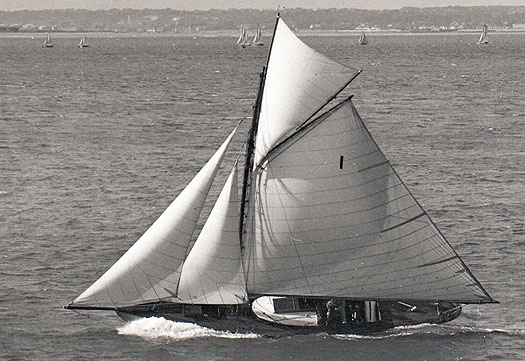
In steady conditions, the Dublin Bay 21 under full sail was manageable, but she provided a real challenge when sailed hard in a blow.
The photo must have been taken in the late 50s, with the boat setting what was to become her last suit of gaff sails. Though they're bearing up reasonably well, a certain bagginess would exacerbate any helming faults. The tiller is well across, suggesting marked weather helm, but don't forget the rudder was well raked, which exaggerated the appearance of the amount of helm necessary, and as the boats aged there was increasing flexibility – to put it mildly - in the connection between rudderhead and tiller.
Thus basically the boat is quite reasonably well balanced. But imagine what happens if a sudden squall strikes. As our old salts have pointed out, the narrow side deck means that the Dublin Bay 21s start to fill with Dublin Bay through the non-self-draining cockpit quite quickly. The mainsheet must be eased as quickly as possible. The ergonomics are terrible, with the mainsheet controlled from cleats outside the cockpit coaming, so a lot of the time in a sudden wind increase the mainsheet – with its tails in a jumble below – is simply let fly, thereby immediately and completely altering the balance of the boat. It would defy all the laws of centre of effort and centre of lateral resistance if she didn't suddenly develop marked lee helm.
So the skill lay in controlling the easing of the mainsheet, one helluva challenge when you're up to your armpits in the cold ocean in ancient oilskins, and everyone is falling over everyone else. And as for suggesting the side-decks should be made wider, that would only make the cramped cockpit even more crowded. But with a skilled helmsman and an even more skilled mainsheet man, preferably of superhuman strength, it could be kept under control, for basically as our second picture shows, it wasn't an inherent fault in the shape of the boat which caused wild fluctuations in balance, but rather a severe temporary imbalance of the sails.

Under shortened rig of full main and jib, but with no tops'l or staysail set, this Dublin Bay 21 in a strong wind is showing marked but controllable weather helm, while the shape of her hull when heeled shows that it is inherently quite well balanced, without excessive fullness of the waterlines aft to distort steering characteristics.
Another topic which came up with the COS brigade (Crusty Old Salts) was the usefulness or otherwise of the topsails. A topsail is only as useful as the quality of its set, and if it isn't perfectly set up to become one with the main, then it can sometimes be worse then useless.
But as our final photo clearly shows, the luff of the Dublin Bay 21s tops'l was actually longer than the luff of the gaff mainsail. And it's the luff length that does the work in going to windward - it's worth remembering that in the great days of gaff rig racing with the big class, the top skippers were so certain of the need for luff length in windward ability that in heavy weather when they reefed the gaff mainsails, they then set up a jib-headed tops'l above the reefed sail in order to maximise luff length within the smaller sail area.
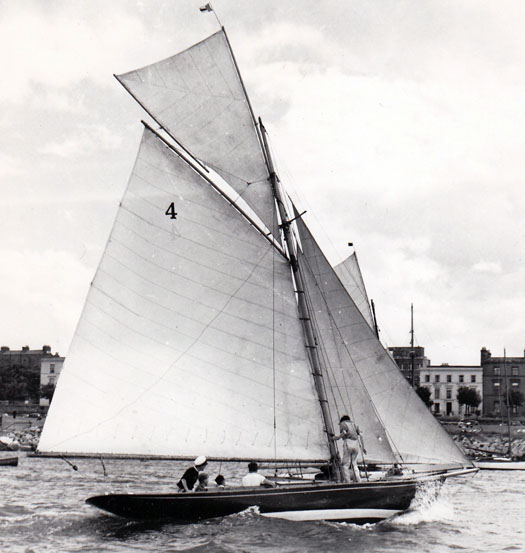
The luff of the jackyard tops'l in a Dublin Bay 21 was slightly longer than the luff length of the mainsail itself, so in sailing to windward, when luff length is at its most important, a well-setting tops'l made a significant difference.
But the problem with a topsail is that if it doesn't click perfectly into place at the first attempt, sometimes it takes for ever to get it right. So with the pace of life becoming more hurried as Ireland entered the 1960s, the time no longer seemed to be available to set up the complete Dublin Bay 21 gaff rig just to go out for an evening race, and the Howth 17s today don't permit topsails for evening club racing.
Back in 1963, when the Dublin Bay 21 crowd were arguing the merits of changing over to Bermuda rig, one of the points in favour of the change was the time it would save. That great sailor and Dublin Bay 21 enthusiast Cass Smullen said this was stuff and nonsense, and claimed he could set up the complete gaff rig of the Dublin Bay 21 in 25 minutes single-handed. So one of the boats was moored just in front of the National YC, and a crowd gathered, drinks in hand, to watch Cass take on the challenge. He did the job in 21 minutes. But they still changed to Bermuda rig.
BIBLICAL EPIC TO IONA
My apologies to Ivan Nelson (see comment at the end of last week's blog – Ed) for the ham-fisted use of English in discussing last week how a Kerry currach – a naomhog from the Dingle Peninsula – came to be sailing to Iona with the first bible in Irish for delivery to the sacred archives there. The bible was of course translated into Irish in 1602 (Old Testament) and again in 1680 (New Testament). We all remember it well. But somehow neither of these translations had ever found its way to Iona, so it was a first in that sense.
Anyway, it's thanks to the crew of Harry Whelehan's 32ft Sea Dancer out of Howth that we got to know of this Kerry voyage, which was done very low key, and in easy stages. Easy stages, that is, if you think it's easy taking a currach all the way up the west coast of Ireland and then past Malin Head and on to Iona.
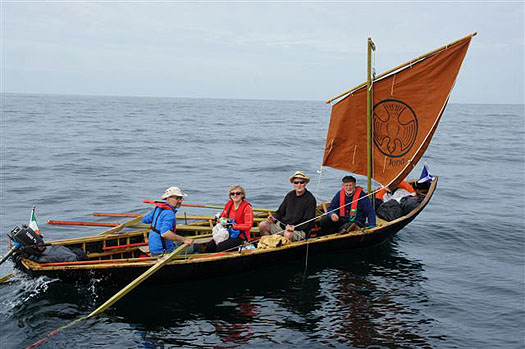
The Kerry currach delivering the Irish bible to Iona last summer completed the voyage in true Christian spirit, with no designated skipper. Photo: Mark Tierney
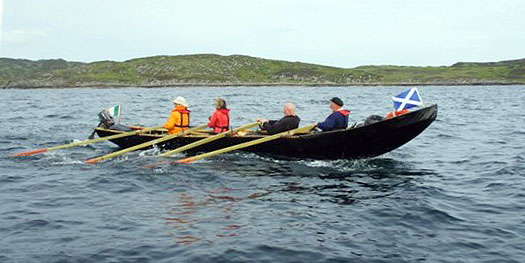
It wasn't all swanning along under sail. In order to get from Ventry to Iona, they often had to pull with a will. Photo: Mark Tierney
The crew of Breanndan Begley, Anne Bourke, Danny Sheehy and Liam Holden did the voyage in three stages over three summers, and in such a spirit of Christian goodwill that the crew of Sea Dancer were unable to tell who if any was the skipper. But the Kerry folk did what they set out to do, then rowed around a few more Scottish islands before heading south, eventually getting to Wicklow. We look forward to hearing about their completion of the circuit of Ireland this summer.
NAOMH BAIRBRE HOME
Thursday nights won't be quite the same now. The six part series on TG4 by Donncha mac Coniomaire and his two shipmates (one of them his father Tomas) about their voyage along the Celtic seaways to Orkney southabout round Ireland from Connemara in the 47ft Galway hooker Naomh Bairbre has come to a successful conclusion. But it certainly shortened the winter watching this demanding ship and her engaging crew making their way to diverse ports which acquired added interest when viewed through the Irish Gaelgoir lens.
Mostly it drew pleasantly to a close as all good cruises do. But there were a few sad moments n the final epiode when they sailed up to Derry to pay their respects to the Galway Hooker An Lady Mor. Donncha had worked in a successful cross-community restoration project on this historic boat back in 2006, and the restoration team then sailed her from the Foyle to Connemara and back when the job was done. But now she lies abandoned and purposeless, ashore in Derry docks, deteriorating rapidly. She could be restored if somebody took action now – I can remember a successful restoration on the same vessel in the mid 1980s by Mick Hunt in Howth. Can't something be done now for An Lady Mor in Derry's year as City of Culture?
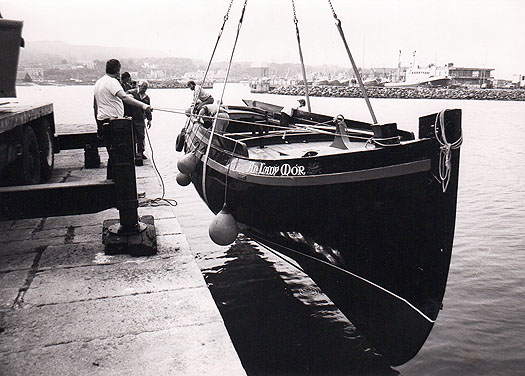
Can she be restored in the City of Culture? An Lady Mor, seen here being launched in Howth in 1985 after restoration by Mick Hunt, is urgently in need of restoration again, this time on the banks of the Foyle. Photo: W M Nixon
Comment on this story?
We'd like to hear from you on any aspect of this blog! Leave a message in the box below or email William Nixon on [email protected]
Classic Circumnavigation With a Home-Made Boat
#circumnavigation – A traditional global circumnavigation was celebrated in Dun Laoghaire last night with the award of the Irish Cruising Club's premier trophy, the Faulkner Cup, to Fergus Quinlan of Kinvara on Galway Bay for the log of the third stage of the 40,486 mile global circumnavigation he completed last year with his wife Kay aboard the 12M steel cutter Pylades, a van de Stadt design which he built himself between 1995 and 1997.
Those of us who have stayed on in Ireland to live through the recession should maybe have taken more notice when, around four or five year ago, architects like the skipper of Pylades started finalising plans to take off for the dream cruise, round the world in easy stages until there was a chance there might be some signs of the green shoots of recovery back home. Of all trades, it was the architectural profession which would have been the first to notice that the flamboyant growth of the tiger years was starting to wilt.
A previous decade in which long distance cruising came top of the agenda was the 1930s, when the Great Depression likewise gripped the world. Then about ten year ago when New Zealand was in localised recession, people simply spent more time sailing in what is a sailing paradise. They already had the boats to do it with, now they'd the free time. But as they didn't have the money for fancy new sails and other gear, they made do with the equipment they had. So this upsurge in sailing activity was of little benefit to the marine industry, but by living frugally afloat the people could enjoy themselves, and returned to work refreshed as the economy stared to pick up.
But in any case, when you've built a boat as good as Pylades, long distance voyaging is the only way to go. She's all of a piece, and is yet another manifestation of the versatility of Dutch designer Ricus van de Stadt (1910-1999). A couple of weeks ago, we were discussing his vision in the use of plywood construction with the Black Soo type from 1956, and Zeevalk before that in 1949. But in 1955 he was also ahead of the posse in glassfibre with the appropriately named Pionier 9, one of Europe's first production boats in GRP. Though long out of production, they're still going strong – there's one of them lying to a mooring in Malahide Estuary, just across the channel from the yacht club.
And as you'd expect from a Dutchman, he was tops with steel. The Caribbean 12 design from which Pylades was built is double chine for ease of construction, yet is still a handsome boat of the ideal size – for the life of me I can't see why anyone needs a proper cruising boat to be more than 38ft long.
With Pylades, Fegus and Kay Quinlan have made the ideal circumnavigation, quietly adhering to their own rule of staying with the boat all the way – they didn't do the usual modern thing of flying home from time to time. But they maintained an informative website, and as someone in a creative profession and a traditional musician too, Fergus is a dab hand with the words and the notions, His log is filled with much entertainment and information and the sort of thoughts that come to you on the long ocean passages – did you know, for instance, that continental separation continues at about the same speed as your fingernails grow?
It's the third year running that Pylades has been awarded the Faulkner Cup, which dates back to 1931 but hasn't been taken three times on the trot before, so history was made last night at the ICC AGM. You don't of course "win" cruising trophies, you're awarded them, which quietly deals with the notion that the essence of cruising is its non-competitive nature.
But were it not for cruising awards, we'd have few enough sources of information to trace the development of this branch of sailing, and to inspire others. Yesterday evening the adjudicator Brendan O'Callaghan had to allocate a round dozen cruising achievement trophies, while there were six other special awards by the committee, including the Wright Salver which went posthumously to Mike Balmforth for his remarkable book Cruising Ireland, published last June, while Sean Flood received the Donegan Cup for his tireless work as Ambassador for Sail Training International. Olympic sailor Annalise Murphy and her parents Con Murphy and Cathy McAleavy were awarded the John B Kearney Cup for services to sailing by this very special family whose breadth of involvement in our sport is unrivalled.
Other cruising trophies included the Strangford Cup to Jarlath Cunnane of Mayo for a 4,500 miles venture north of Russia with his much-travelled Northabout, the Atlantic Trophy went to Maire Breathnach of Dungarvan for the transoceanic crossing which completed the circuit of North America by the gaff ketch Young Larry, Paul Butler of Dun Laoghaire took the Round Ireland Cup for his informative account of a classic circuit, Brian Black of Strangford got the Rockabill Trophy for his voyage to Greenland with the 35ft Seafra, and Dickie Gomes (also of Strangford Lough) received the Fingal Cup for the Centenarian 36ft Ainmara's cruise to the Outer Hebrides and Scotland's west coast.
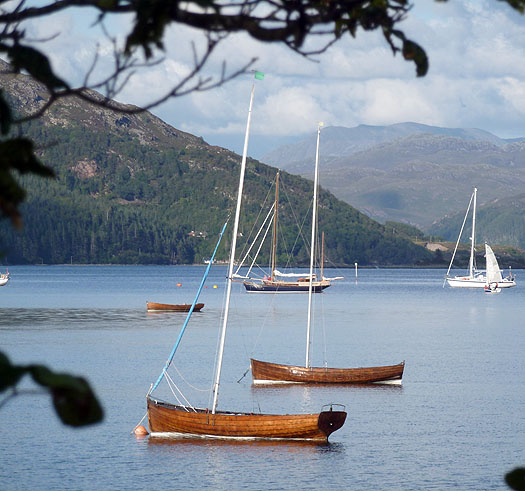
The John B Kearney-designed and built 36ft yawl Ainmara anchored off at Plockton in Wester Ross during her Centenary Cruise to Scotland which was awarded the ICC's Fingal Cup. The club's John B Kearney Cup for Services to Sailing, commemorating Ainmara's renowned designer-builder, was awarded last night to leading Dun Laoghgaire sailing family Con Murphy and Cathy MacAleavy and their daughter, Olympic sailor Annalise Murphy. Photo: W M Nixon
In other cruises, Garry Villiers-Stuart received the Wild Goose Cup for a "pilgrimage voyage" with the 1890-vintage cutter Winifeda of Greenisland, the Marie Trophy for the best cruise by a boat less than 30ft LOA goes to Mick Delap whose gaff cutter North Star is just 24ft long, the Glengarriff Trophy goes to former Fireball champions Adrian and Maeve Bell from Strangford for a cruise in Irish waters which was good despite the weather, the Perry Greer Bowl for a first log goes to Ann Lyons for a cruise among Celts fom Cork eastward, the Wybrants Cup for the best cruise in Scotland goes to Harry Whelehan of Howth whose venture to the Hebrides with the 32ft Sea Dancer found itself providing support for a currach from Kerry delivering an Irish language Bible (the first such apparently) to the religious community at Iona, and the Fortnight Cup for the best cruise in 16 days went to David Williams of Strangford Lough who managed to take the owner-built steel cutter Reiver to southern Brittany, 600 miles in the fortnight, and they got far enough south to be clear of the baleful effects of the jetstream which was blighting the weather over Ireland.

Awarded the Fortnight Cup. The 35ft steel cutter Reiver, to a design by Ian Nicolson of Alfred Mylne, was self-built by David and Peter Williams of Strangford Lough, and launched in 1988.
THE CARIBBEAN 600 SHOW GOES ON
Irish hopes in the RORC Caribbean 600, which starts on Monday from Antigua, received a horrible setback a week ago when Alan McGettigan of Dun Laoghaire's recently-acquired Swan 48 Wolfhound foundered just north of Bermuda. The boat was on a very challenging delivery passage from Connecticut via Bermuda to Antigua to take part in the race, and the crew of four with the owner in command were in no doubt about the scale of the task they faced. But with snowstorm Nemo developing over northeast America, the conditions in the Gulf Stream became extreme, and with multiple systems failures, a rescue by activating the EPIRB became necessary.
Wolfhound was a Swan 48 to this 1994 Frers design.
Nevertheless the sinking of a boat of this quality is extremely unusual, but we'll have to await the word from the crew (the ship which picked them up gets to Gibraltar next Tuesday) to learn if it was impact against the ship which sank Wolfhound. She was one of the Frers designed Swan 48s of which 57 were built between 1995 and 2003. The design was developed as the natural successor to the very successful Sparkman and Stephens-designed Swan 48 which was one of the classics which established the Nautor brand, so although Wolfhound was called a Swan 48, she was in fact just a smidgin under 51ft. This gives her even more Irish interest, as it means that at the time of her building, she was a sort of up-dated production version of Denis Doyle's legendary Moonduster, built by Crosshaven Boatyard in 1981, which was last reported to be based in Norway with an offshore sailing school in Trondheim.
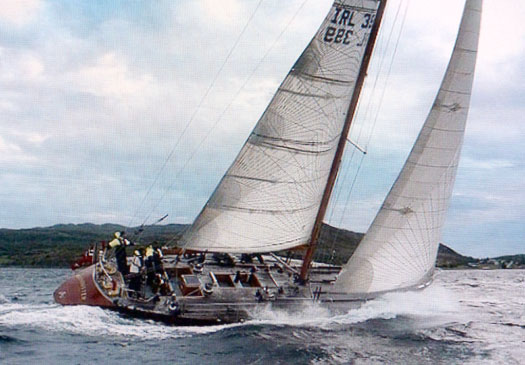
The Duster sails on. Denis Doyle's famous Frers sloop steps out seven years ago near her home port of Trondheim in Norway.
Meanwhile out in Antigua Irish hopes in the Caribbean 600 now rest with Dun Laoghaire's Michael Boyd, Niall Dowling and John Cunningham with the chartered First 40 Lancelot, the Reichel Pugh 78 Whisper skippered by Mark Dicker, and Northern Ireland's Peter Metcalfe in command of the 100ft Liara, though of course American Ron O'Hanley with the highly-fancied Cookson 50 Privateer, will find he immediately reverts to the nationality of his ancestors if Privateer does the good deed.
Defending champion Ran, the JV 72, isn't taking part this year, but her newer near sister Bella Menta (Hap Fauth, USA) is probably the bookies' favourite, though Mike Slade's ubiquitous hundred footer Leopard is on a roll after setting a new record in the Transatlantic race (she was on charter to Nik Zennstrom of Ran who fancied a bit of extra comfort to cross the pond) and can never be ruled out of contention.
NAOMH BAIRBRE AND A SILE NA GIG
The addictive Turas Huiceara on TG4 at 9.30 pm on Thursdays continued this week with Donncha and his hard-working pair of shipmates on the giant Galway Hooker Naomh Bairbre managing to get their enormous mainsail back in action with the new boom made from a tree felled in Stornoway.
Their voyage in search of Gaelic links along the Celtic seaways brought them to the Orkneys where - as suggested here last week - there's little enough trace of the Gael in a Viking-dominated archipelago. But a visit to St Magnus Cathedral, the remarkably fine mediaeval church in the Orcadian capital of Kirkwall, discovered what is apparently the most northerly Sile na Gig, a piece of unsubtle Celtic statuary incorporated into a stone archway.
There is no doubting what this little stone carving is all about - it makes even the most blatant Playboy centrefold seem totally demure by comparison. If this is the image of Irish womanhood being given to the Vikings of Orkney, no wonder they came down here in their hundreds expecting rape and pillage.
Finally heading south, the Naomh Bairbe found her way into the Caledonian Canal, with the site of the Gaelic-destroying Battle of Culloden nearby providing a mournful visit. But such are the demands of a continuous cruising narrative that there wasn't time to put Culloden into perspective, relating it to 1745 and the expedition into Scotland by that world-class messer Bonny Prince Charlie. You could understand, though, why he mightn't be mentioned – it's difficult to be serious about a man named after three sheepdogs.
Going down Loch Ness, there were interesting insights into the survival or otherwise of Gaelic in Scotland, with one speaker making the point that its disappearance means that people aren't really able to properly read the maps of their homeland, as the names of the significant features are all based on Gaelic.
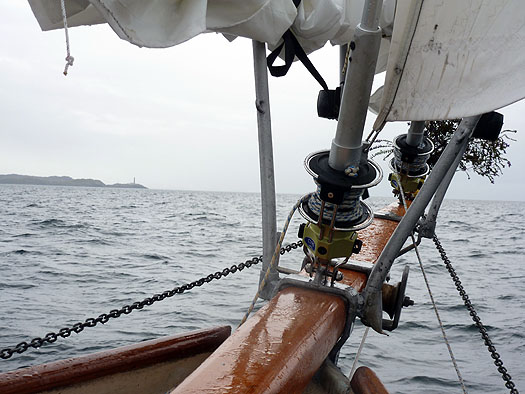
The Gaelic says it all. The Scottish mainland's exposed most westerly point is Ardnamurchan. It means the Headland of the Great Seas – this photo was taken in unusually smooth conditions, with the wind off the land, a rare experience0. Photo: W M Nixon
In fact, both the Clyde Cruising Club Sailing Directions in Scotland, and the ICC books on the Irish coast, make a point of including a large glossary of Gaelic coastal terms, as it does indeed greatly aid in "reading" a coastline. It may be a help to the survival of the old tongue, but on the other hand it simply reinforces Gaelic's featherweight status as no more than a holiday language.
Next Thursday sees the final episode of the Turas Huiceara saga. Whatever about its success as a television programme, it has been a fascinating cruise on an interesting boat, and I can only hope the crew of the Naomh Bairbe start to get some quiet enjoyment as they get nearer to home in Connemara.
Comment on this story?
We like hearing from you! Leave a message in the box below or email William Nixon on [email protected]
Royal St. George Yacht Club to Host First Irish 'Dinghy Sailing Summit'
#dinghy –In a welcome boost for Irish dinghy sailing, senior sailors are invited to what is Ireland's first ever 'dinghy summit' to hear 'thought provoking' comment from some of the country's leading exponents of the sport, including 2012 Irish Olympic Laser sailor James Espey and former Laser II world champion Noel Butler.
Butler will talk about his psychology of winning, being prepared and some specific Fireball topics.
Butler will also cover his story about how he came into the sport late and took a measured approach towards training to eventually win a world championship.
James Espey is expected to share tips for going fast in a Laser.
Also speaking is Graham Elmes who has represented Ireland in many classes including the Mirror, SB20, Etchells, Firefly (team racing).
Following on from his very popular talk on starting techniques and the first beat Graham plans a revised version of this talk.
The event takes place on 23rd Feb from 10:30am in the Royal St. George George Yacht Club's Junior Room. A fee of €10 at the door.
Making Sailing in Ireland Less Elitist
#islandnation – Making sailing less elitist; BIM addressing difficulties between fishermen and processors;Captain defends his sunken ship; Cork brotherly angling duo amidst lots of cod; Using one sea to help another; RNLI independence and a giant squid is filmed.
CREATING A BETTER ATTITUDE IN SAILING
I believe strongly in making sailing a sport for everyone, that every opportunity should be taken to encourage more people into sailing and that clubs should be active in this regard. But there are still people who regard sailing as an exclusive sport which is difficult to get involved in and it has to be said that some clubs, by the attitudes they display, create an unwelcome aspect of elitism and exclusivity. The Irish Sailing Association has made the availability of the sport to everyone a keynote of its development commitment, but I am still approached by people who tell me that they have found it difficult to get into the sport.
I have been telling Norbert Reilly, Commodore of the Irish Cruiser Racing Association that I welcome the Association's launching of a nationwide 'Crew Recruitment and Training Programme.' He is enthusiastic about the project:
"ICRA represents 4,300 keel boat sailors and the objective is to create a pathway to get on to a racing yacht, promote local training and provide national standards for the various positions on a racing boat. It is open to all levels of sailors from those interested in midweek social racing, right up to a position on the Irish Commodores Cup Team. The initial roll-out of the programme will take place on April 21at Howth Yacht Club in Dublin where 120 slots will be available on the ISA's J80 yachts. The programme will consist of both water and shore-based sessions led by top Irish sailors"
ICRA will be working with the ISA and yacht clubs under the slogan: 'More Sailors...More Sailing'. I hope it succeeds. For those interested in getting involved go to the website www.cruiserracing.ie to register.
I'm delighted to see that Barry Rose is remaining actively involved with ICRA and the creation of a Commodores Cup team. ICRA has invited declarations of interest from owners to participate in an Irish challenge for the cup which was won in 2010 by the team of Anthony O Leary's Antix; Dave Dwyer's Mariners Cove and Rob Davie's Roxy. The Commodores Cup won't be sailed again until next year, so there is time to prepare an Irish team. Barry Rose will be the ICRA rep looking after the Ireland Team. Email for those interested: [email protected]
VOLVO RACE PORT ANNOUNCEMENTS
There will be two stop-overs at ports in Brazil for the next Volvo Race, the 12th edition. Itajaí, in the state of Santa Catarina, has been named in addition to Recife. The remainder of the route for the 12th edition of the Volvo Ocean race will be revealed over the coming weeks. Ireland is not expected to be involved.
Fishing – BIM DEALING WITH DIFFICULTIES BETWEEN FISHERMEN AND PROCESSORS
There have been on-going difficulties between fishermen and fish processors about the difficulties fishermen have claimed in selling their fish, getting poor prices, while processors were alleged to be buying more foreign-caught fish than supporting the Irish industry. Bord Iascaigh Mhara, the State fisheries board, has become involved and has held a number of meetings involving both sides. It seems that agreement has been reached acknowledging that there has been "poor communication between fishermen and processors" and that this has led "to a lack of supply and quality in the whitefish sector."
That is according to BIM whose CEO, Jason Whooley, has said that the whitefish sector faces serious challenges and that on-going profitability is "difficult for many of the vessels and businesses involved. Processors are competing in an extremely demanding market in terms of volume, consistency of supply and the high level of standards and quality checks that must be achieved to maintain contracts in these markets. Fishermen are working under the constraints of fuel costs, quotas, difficulties, knowing what species of fish are required by the market and when and how prices are affecting the sustainability of the catching sector to reinvest in their business," says BIM. "All parties agreed that working together, as a united entity, with greater communication would lead to an improved whitefish sector. It was agreed that the main issues to resolve were a clear communication system between fisherman and processor, scheduled landings and improved quality for some vessels."
BIM is to facilitate a pilot scheme addressing these issues over a four-to-six-week period after which fishermen and processors will meet again with BIM. This appears to indicate progress.
Shipping – CAPTAIN DEFENDS HIS SUNKEN SHIP
77-year-old Captain Apostolos Mangouras, Master of the Bahamas-flagged tanker Prestige which broke up off the coast of Spain in November 2002 has told a court there that the decision of the maritime authorities in Spain to refuse his ship a place of refuge when it was in trouble was "the worst possible" decision to make. He faces a possible sentence of 12 years in jail if found guilty of causing environmental damage when the tanker broke up and spilled over 70,000 tonnes of oil causing heavy coastal pollution. He has argued that this would not have happened if the ship had been allowed into sheltered waters to deal with problems which had occurred. He said the 1976 ship had never suffered a single detention for safety problems and should have been give refuge.
The former Head of Spain's Merchant Marine Directorate has also been put on trial over the incident, accused of causing environmental damage and he has defended his decision not to allow the Prestige into sheltered waters.
The vessel was forced to remain at sea in heavy weather for six days before it broke in two when it was about 200 nautical miles off the Spanish coastline.
The case is highlighting the problems for Shipmasters when they need a port of refuge in difficulties and are refused. The shipping industry has argued that this attitude by port states increases the danger of pollution and environmental problems.
Lifeboats – RNLI WILL REMAIN INDEPENDENT
I met Martyn Smyth, Divisional Inspector and Operations Manager for the RNLI in Ireland at Helvick last week when we discussed improvements and upgrading of the service planned by the organisation. He made it clear that the RNLI will remain independent of State involvement.
Looking over the annual rescue statistics for the RNLI in Ireland they show that the majority of calls were to pleasure craft, which accounted for 482, though this number was down from 505 in 2011. There were 115 emergency calls to fishing vessels. The call-outs indicate a lot of problems on the water, with more than half caused by people on leisure craft, including mechanical failure, running out of fuel and grounding. Twenty people a week were rescued by Irish lifeboat crews last year during which they spent over 10,000 hours at sea on emergency call-outs.
ENNIS ENTHUSIAST HONOURED
One of the country's best-known lifeboat supporters and enthusiasts, a former Valentia lifeboatman himself, Dick Robinson, is to be honoured with the award of a Gold Badge by the RNLI. This is the highest award to lifeboat supporters. Dick is also an historical expert on the lifeboat service in Ireland.
Angling – CORK BROTHERLY DUO
Brothers Noel and Christy Lane from Cork are pretty adept anglers, having made several good catches and are in the news again with the landing of a 3.18 lbs. specimen whiting off Cork when they were fishing along with other anglers out of Kinsale aboard charter skipper Butch Robert's boat Sundance Kid. Christy made the catch using mackerel-baited 'Shamrock Red Devil' lures.
BIG COD IN CORK!
Anglers have been taking catches of big cod off Cork Harbour. On Joe Lynch's Wreckhunter a 14lb. fish was caught while other catches of cod up to 12 lbs. are also reported.
COMPUTERISED FISHING ROD
An enthusiastic angler and inventor in Kansas in the USA has devised a computerised angling rod. The 'POLETAP SMARTROD' has an alarm and flashing red LED lights which go off when a fish takes a fly on the end of the line. The electronics are said to be water-resistant and the system works with any reel. It has an 'accelerometer' which will immediately detect with a high-sensitivity setting when a fish takes a lure.
The inventor, Ed Hope, says the alarms can be turned off after a fish strikes – in order not to annoy other anglers! Additionally, once the user starts reeling the line in, the fish-detecting microprocessor temporarily shuts down. This keeps the rod from flashing, shrieking "and generally carrying on throughout the fish-landing."
But will it take the fun and anticipation out of angling?
Marine Environment – USING ONE SEA TO HELP ANOTHER
A report issued by the World Bank has said that the Red Sea could be used to replenish the shrinking Dead Sea. The possibility of linking the two has been suggested for over a century. It gained urgency when the shores of the Dead Sea were found to be receding at a rate of 3.3 feet every year. An underground pipeline could channel water from the Red Sea 112 miles north to replenish the Dead Sea according to the Bank but this suggestion has been criticised by environmental groups who warned of adverse effects, such as changing the Dead Sea's colour or underground fresh water springs if they were polluted with seawater from the Red Sea.
CREATING A NEW ISLAND
The Belgian Government is considering a plan to build a new island in the North Sea to store wind energy. The intention is to build it from sand 3 kilometres off the coastline from the town of Wendnine. By pumping water out of a hollow in the middle of the island, the intention would be to store power, even though scientific opinion is that there are difficulties in storing energy generated from wind power. The Belgians are taking this approach to reduce dependence on nuclear power after two of the country's nuclear stations were shut down when cracks were found in reactor casings. It could take five years, however, to go through the planning stages and build the new island.
GIANT SQUID FILMED
Video footage of a giant squid filmed in its deep ocean habitat has caused huge interest in the marine world. It was filmed from a small underwater research submarine in the North Pacific Ocean, was about 30 feet long and silver and gold in colour. Marine biologists who shot the footage, said it was missing two tentacles
and its stomach had been removed, seemingly because of a hole in its body. "Something strange must like to eat those parts," said Dan-Eric Nilsson of Lund University. He also noted that the squid seemed to have a colour-changing system, which contained pigment and reflected light, very deep inside the giant squid's body cavity.
In recent months, researchers have also learned more about giant squid eyes. The diameter of these eyes measures two to three times that of any other animal. Giant squid eyes measure 10 inches, making them about the same size as a large dinner plate. Big is optimal for sight in deep-water environments apparently. It is believed that a giant squid can grow up to 55 feet long.
Email: [email protected]
Regular marine news from www.afloat.ie
on twitter:@afloatmagazine
on Twitter: @TomMacSweeney
Brian Craig is December Sailor of the Month
#sailorofthemonth – As we look back over the extraordinary mixture of memories stirred up by the Irish sailing season of 2012, one exceptionally good deed stands out in a sometimes slightly wicked world.
Questions were asked about some major events in Ireland and abroad during 2012, while in others, distasteful rows blew up which could have been much more competently handled. But over and above it all, and glowing with increasing strength as the passing of time enhances the recollections, is the happy memory of the Four Star Pizza ISAF Youth Worlds in Dun Laoghaire in July.
With 63 nations involved, it was the most international sailing event ever seen in Ireland. It involved the active input of an army of volunteers ashore, and a navy of volunteers afloat. With so many people taking part at some level or other, the scope for friction – at the very least – was incalcuable.
Yet the ISAF Youth Worlds seemed to effortlessly achieve that true spirit of local, national and international goodwill to which to many comparable events aspire, but not all realize. It made a lasting impact, and was lavishly and deservedly praised by outgoing ISAF President Goran Petersson at the ISAF Conference in November.
Only with a very exceptional administrator and delegator leading an inevitably complex organization can such a satisfactory outcome be achieved. Irish sailing in general, and Dublin Bay in particular, is fortunate in being able to call on the services of Brian Craig to lead the administration in events as demanding as the ISAF Worlds. Not only did he put in the long hours necessary to ensure its smooth running, but long beforehand he gave generously of his time to ensure that Dublin Bay's claim to stage this event was internationally acknowledged and approved. Brian Craig is the Afloat.ie "Sailor of the Month" for December in celebration of his unrivalled contribution to the sailing season of 2012.
IT'S GREEN FOR GO IN HOBART
Irish sailors in Australia have been on a roll in the annual 628-mile Rolex Sydney Hobart Race, with major input into the crewing of the two top boats. After a virtually perfect race in tactical and navigational terms, veteran owner Bob Oatley's hundred footer Wild Oats XI took line honours, and in doing so knocked 16 minutes off the course record she established in 2005.
As Oatley's team - headed by skipper Mark Richards – constantly update and re-tune the big boat, the Wild Oats which established the new record yesterday was a very different beast from the winner of 2005. But the course they had to sail was the same challenging slog down the coast of New South Wales, across the Bass Strait, and up the often flukey estuary of the Derwent River to the city centre finish in Hobart.
One false call from experienced navigator Adrienne Cahalane – whose people hail from Offaly – and a mountain of effort beforehand and afloat would have amounted to nothing. But after blasting away from a perfect start to establish what is believed to be a record for the first short stage from the harbour to Sydney Heads, Wild Oats never put a foot wrong.
At times she was even showing as the overall handicap leader, which is unusual for the biggest boat in the fleet. But for much of the race, the handicap lead was being battled between the defending champion, Steve Ainsworth's 63ft Loki with Gordon Maguire (originally from Howth) as sailing master, and the hot new boat on the block, Peter Harburg's 66ft Black Jack, whose crew - including Olympic Gold Medallist Tom Slingsby - made no secret of targeting Loki.
Being slightly larger, Black Jack seemed to be establishing an unassailable lead, as the quicker you could get south, the more favourable the easterly winds became. This meant that far ahead, not only did Wild Oats end up sailing her own race, but she carried the breeze right to the end, while the wind was losing power out at sea. As the hours ticked by after the big boat was finished, the chances of either Black Jack or Loki saving their time on the Oatley boat evaporated. Wild Oats XI had the treble – line honours, course record, and overall win. But in the private race with Black Jack, Maguire and his team somehow found extra microns of performance, and though they were beaten by Wild Oats by more than two hours on corrected time, they in turn beat Black Jack by 2 hours 3 minutes.
It's a good weekend for Irish sailing down Hobart way. Jeff Condell of Limerick was also on the race, on the strength of veteran skipper Syd Fischer's 100ft Ragamuffin Loyal, and though with some gear breakages they weren't able to match the blistering pace set by Wild Oats, they still took second on line honours, quite an achievement when you remember the hands-on skipper is 85 and his unmatchable CV in sailing includes the overall Fastnet win way back in 1971.
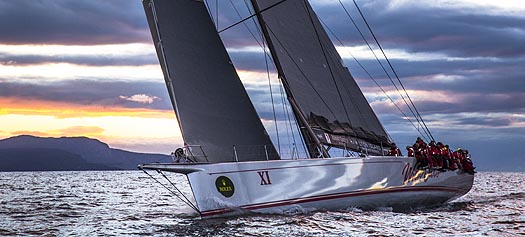
Wild Oats on track for the treble in the Rolex Sydney Hobart 2012. Photo: Daniel Forster/Rolex
SO FAREWELL THEN, EUROPEAN YEAR 2012 FOR ACTIVE AGEING AND SOLIDARITY BETWEEN GENERATIONS, AND HELLO TO THE GORB
Did you know that we've just lived through European Year 2012 for Active Ageing & Solidarity Between Generations? Me neither. And even if someone had told me, I'd have forgotten the beginning of a title of such length and contrivance before I'd even got through to the end.
May God in His Mercy protect us from well-meaning bureaucracies. We know that there are agencies in Brussels which make a tidy living out of putting an often costly structure on activities which any healthy local community would regard as so normal as to be scarcely worthy of comment. But the European Commission for Employment, Social Affairs, and Inclusion, with its European Year 2012 for AA & SBG, surely takes the biscuit.
The reason we've come across this absurdity is that in mid-November we received a news release from Brussels telling us that two Irish AA & SBG projects took second and third prize in a competition throughout Europe which attracted 1300 entries in six categories.
Millstreet Community School's Living Scenes programme, running for seven years, has seen retirees and teenagers "brainstorming together to come up with creative multi-media projects aimed at bridging the gap between young and old".
That won a second place in "Intergenerational Encounters", while third place in Journalism went to a four part RTE series about Age and the City, which we're assured was "highly entertaining for all ages".
This sort of thing is all very well, but is it life as we should know it? The whole business of ageing and retirement is built around chronological ageing, which misses the point entirely. It's what you do and how you feel that gives a much more accurate gauge of real age, rather than a sum of years. There's a large cohort of seniors out there who are so busy, so absorbed in getting on with multiple interests, that they would no more think of joining active ageing groups or taking part in formalized inter-generational encounters than they would contemplate no longer owning a boat, or not having a dog about the place.
Back in August I went cruising to the Western Isles in a hundred year old boat, and was Ship's Boy for a Skipper and First Mate who were both 74. But our doughty skipper belies all received opinion about ageing, as he looks after his high-maintenance old boat himself, plus he is also Senior Mechanic and Retrieval Driver for various vintage vehicles which his wife and daughter need for their string of show-jumpers.
As for the First Mate, he plays rugby for the Perennials, and just last winter the highlight of their season was a tour to the rugby paradise of Limerick. He reminisced during our cruise about the techniques required going shoulder-to-shoulder against Peter Clohessy – not an experience for the faint-hearted.
With this splendid double lineup of Active Ageing, I had to supply the Solidarity Between Generations, even if the Skipper was much more agile than the Ship's Boy. This was demonstrated when the Skipper became so irritated by the flapping of the leech of the high cut jib that, off the coast of Skye, he quickly climbed on the First Mate's shoulders in order to tension it.
There are some unkind people who suggest that if I was really interested in promoting Active Ageing, then I should have let fly the jib sheet while these venerable gymnasts were doing their thing. That undoubtedly would have added a certain je ne sais quoi to the performance. But instead I took a photo, for here indeed was something for Brussels' attention. If we're going to encourage active ageing, then we're going to have to accept that senior sailors are going to be clambering about on the broadest shoulders aboard in order to adjust the rig of their ancient boats. And we're going to have to accept that they're of a generation that regards safety harnesses and lifejackets as restrictive of movement.
So in the first instance, let Brussels commission us for a Feasibility Study for a GORB – a Golden Oldie Rescue Boat. This would follow the seniors about as they wander across the ocean, and gather them in when they fall off their own ancient craft. The GORB would need to be a proper cruising vessel, and as her crew would include a significant proportion of seniors, she in turn would need another GORB to follow her.
And another one again. We'd build up a fleet, eventually sailing round in a vast circle. We'll call it The Gathering Cruise.
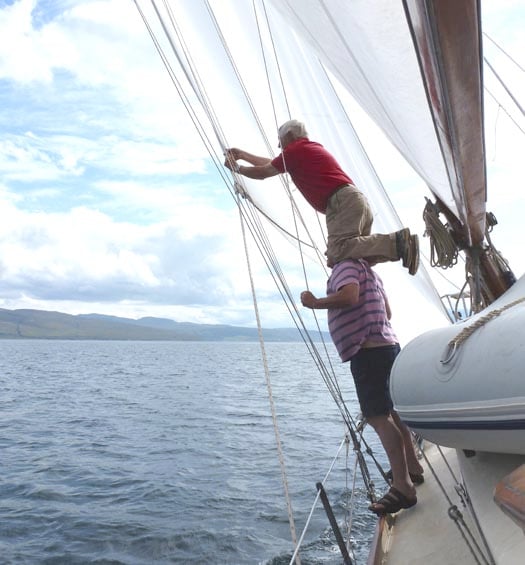
These guys need a GORB. The combined age of this acrobatic troupe is 148 years, with neither safety harness nor lifejacket in sight. Photo: W M Nixon



























